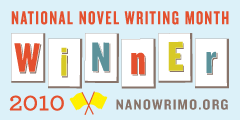 After thirty days of thinking, sorting, and scribbling, I turned a variety of notes and blog posts into a very rough and informal book draft of 52,967 words.
After thirty days of thinking, sorting, and scribbling, I turned a variety of notes and blog posts into a very rough and informal book draft of 52,967 words.
Now as I confessed a month ago, I went about the process as a rebel—writing a nonfiction, academic piece and borrowing from existing work as appropriate. Fortunately, rebellion is sanctioned in this contest, and I am now officially a National Novel Writing Month winner for 2010.
The Secret to My Success
I would never have taken on this project without a little nudge from Literature & Latte’s Scrivener NaNoWriMo 2010 Trial, a special trial version of a wonderful word processing program for Mac (and coming soon for Windows). Ryan Cordell reviewed Scrivener for ProfHacker, and that’s when the program initially caught my attention. When I saw that the Literature & Latte folks were offering a discount for NaNoWriMo participants, I knew I had to download the program and give the month-long writing event a try.
After a few days, I realized that Scrivener had completely changed the way I work on a longer document. Honestly, the program made it possible for me to see how my practice of writing short pieces could work in the context of producing a larger document.
I write dozens of short documents every month, almost always blog entries composed in Dreamweaver for upload to a blog platform like WordPress. When I’m not writing blog entries, I am writing very structured pieces like lesson plans and strategy guides for ReadWriteThink.
My greatest fear has been that I would never figure out how to write another book. I’ve become so used to these shorter, structured pieces, that I just couldn’t think through the problem far enough to understand how to structure and write a fluid, longer piece.
After playing with Scrivener a bit, I realized that I could create and import dozens of shorter pieces as Texts, arranging them in folders, and dragging them around on the cork boards until I had what I wanted. I soon had six chapters sketched out, and I ultimately ended up with 73 short texts sorted into those folders.
Admittedly, the draft is not close to finished. There’s little flow or consistency at this point, but when I realize that I went from 0 words to a fleshed-out folder outline and over 50,000 words in a month, I know it wasn’t just the pressure of the NaNoWriMo deadline that did it. The secret to my success was that Scrivener allowed me to collect my existing blog posts, compose some additional short texts, and end up with a book draft.
My Take-Away Lesson
After participating in NaNoWriMo, I realize that I was letting my belief that I had to have a finished idea for a book in my head block me from getting started. Working with Scrivener helped me recognize that my practice of writing short pieces could still work when I composed a larger book-length manuscript.
As I worked on my draft, I quickly learned that I could turn my blog posts into a very rough book draft simply by sorting things into reasonable categories and adding some missing pieces. My take-away lesson is to remember that I don’t need that finished piece figured out to create a longer text. I just need to be open and creative about how I fit my ideas together.
The Outcome
So here it is 30 days later, I have a roughly-arranged manuscript, which I’m currently calling Designing Digital Writing Assignments.
I’m not sure when I’ll get the manuscript finished or if I can find a publisher. I’m trying not to worry about that right now. It’s enough of an accomplishment to realize that I now know how to turn my blog posts into a book draft. I even know what I want to write a third book about and how to do that. Besides, I need to get back to anxiously checking my email for that 50% off discount for Scrivener that I should get from Literature & Latte as a NaNoWriMo winner.

